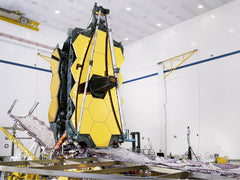- Home
- About
-
Telescopes
- Binoculars
-
Accessories
-
Guides
- Gift Cards
- Contact
December 16, 2021
 |
Way back in the ’90s, scientists were asking questions about what should replace the pioneering Hubble Space Telescope. They soon had their answer in the form of the James Webb Space Telescope (JWST), named after the second appointed administrator of NASA from 1961 and 1968, during the Apollo programme. In 2004, construction began, and the telescope was pencilled to be launched in 2007, but due to its overwhelming complexities, it was pushed all the way back to 2018. However, it still wasn’t ready for its big mission. |
Fast-forward three years later to this very moment, this game-changing telescope is ready to explore space like never before! It is the most ambitious engineering initiative ever attempted, and if all the parts work as planned, it will do nothing less than rewrite the history of the cosmos and answer the universe's most pertinent questions.
 |
 |
 |
With a $10 billion price tag, the labour of over 10 000 people and an immense international collaboration between NASA, the Canadian Space Agency (CSA), and the European Space Agency (ESA), it is set to blast off on 24 December from Kourou in French Guiana on an Ariane 5 rocket. The telescope will be placed a phenomenal 930, 000 miles from our planet, directly behind it from the Sun’s point of view in the second Lagrange point (L2). Unlike the Hubble, which orbits around our planet, JWST will orbit the Sun, collecting information for at least five years with the hope of 15.
The Webb is pegged as the new frontier of space exploration, fitting into a bigger puzzle that seeks answers to discoveries made by its predecessor, as well as the Kepler.
The advanced engineering will allow it to peer back to a few hundred million years after the Big Bang. As it ventures into deep space, deeper than ever before, there is a big chance it will raise more questions just like the others that came before it. After all, every time new equipment is built, surprises await!
There are two big missions assigned to the telescope that will take up 50% of its time. Firstly, it will explore the history of the cosmos by trying to find answers to how stars and galaxies were formed and how they will evolve. Secondly, it will gather more information about exoplanets (planets that orbit stars outside our solar system), so scientists can learn more and investigate the potential of life by studying their atmospheres.
The remaining time will be spent trying to find answers to a range of questions raised by Hubble and Kepler - on topics such as dark matter and energy, supermassive black holes, Jupiter’s icy moon, and the innumerous planets that decorate our solar system, including billions in our Milky Way that could potentially be habitable!
The telescope will explore deeper into space than ever before, made possible by its infrared capacity, which has long wavelengths to penetrate dust more easily and allow for a clearer view of the early universe covered in clouds. It is a major upgrade from Hubble's use of ultraviolet and visible light. Infrared enables scientists to go further back in time thanks to a phenomenon known as redshifting, which captures light from objects further away.
Its incredible technological abilities are made possible by an enormous primary mirror, spanning 6.5 meters wide and comprising 18 hexagonal mirrors, optimised for reflecting infrared lights from the far reaches of the universe. Alongside this, the observatory has four scientific instruments for imaging cosmic objects and spectroscopy (breaking down light into separate wavelengths to study cosmic matter in terms of its physical and chemical properties).
With every discovery of the universe, there are innumerable questions that follow. James Webb Space Telescope hopes to provide answers to some of these and make exciting new discoveries along the way! With so much to be explored, make sure to follow us on Facebook and Instagram, where we will keep you updated on this engineering marvel’s pioneering journey.
June 09, 2022
January 24, 2022
January 13, 2022
